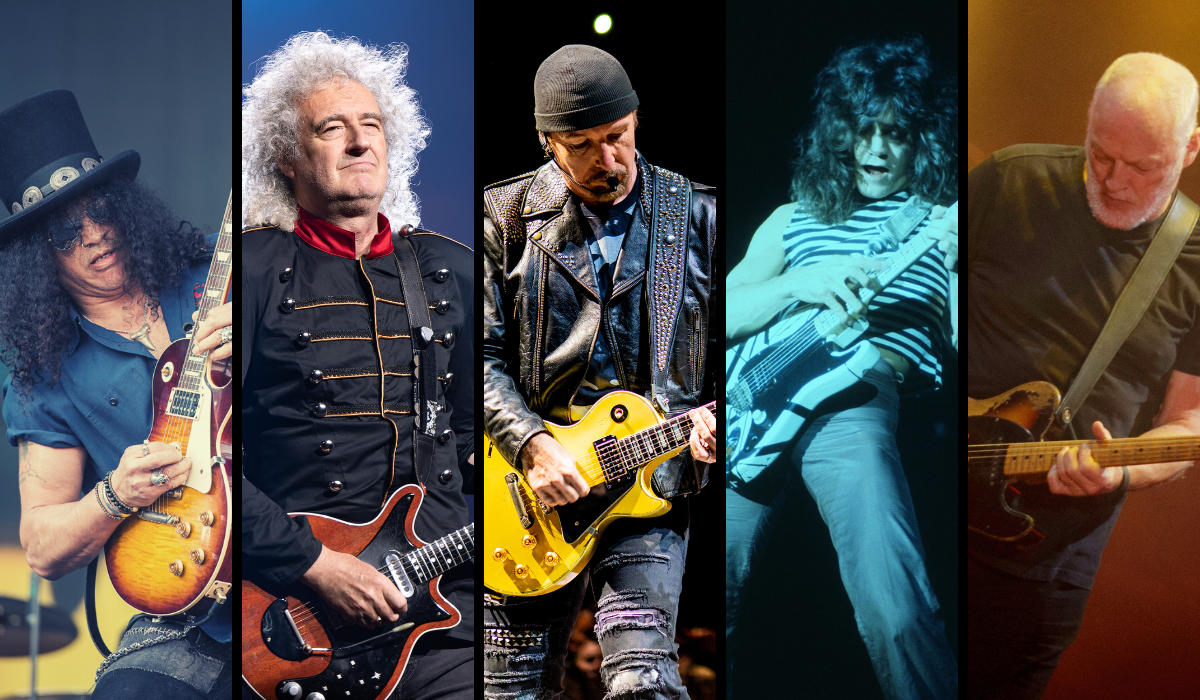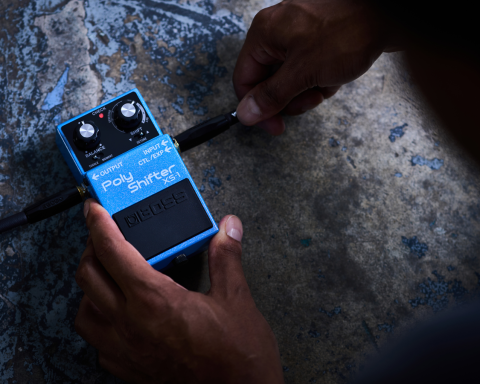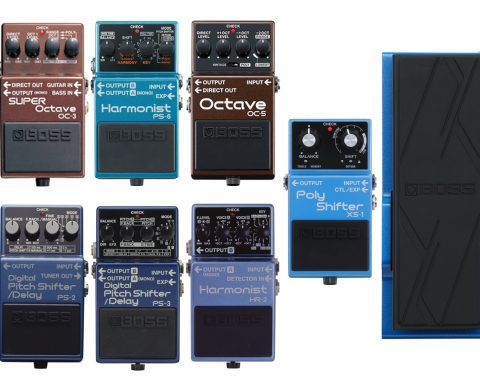Let’s examine some of the most popular delay pedal artists and their iconic sounds. Along the way, we’ll explore their pedals and how to emulate their tones. Come along as we look at the delay sounds of Eddie Van Halen, John Mayer, John Frusciante, The Edge, David Gilmour, Brian May, and Slash. We’ll also include other delay mainstays like Bloc Party, The Verve, Mars Volta, The Temper Trap, Tame Impala, and Radiohead. Dive into how these innovators used delay to carve unique sonic identities and create memorable musical magic.
Eddie Van Halen
Eddie Van Halen used Echoplex style delay for the first two Van Halen albums, then graduated to the Roland SDE-3000. He pioneered incorporating two units in his three-cabinet wet/dry/wet setup. EVH used the dry path from a single amplifier in the middle cab, and the left and right cabs amplified with wet-only delay effects. This gave him a massive, expansive sound that filled arenas. Listen to how he used the delay pedal in the intro to “Ain’t Talkin’ Bout Love.”
EVH and BOSS engineers designed the SDE-3000EVH Dual Digital Delay to replicate the exact sounds for which he was famous. Thanks to powerful presets, the pedal replicates EVH’s wet/dry/wet setup from his three-cabinet rig.
"EVH and BOSS engineers designed the SDE-3000 EVH Dual Digital Delay to replicate the exact sounds for which he was famous."
Capturing The Eddie Van Halen Sound
- Delay Type: Analog or digital
- RE-2 Space Echo: For classic tape machine wow and flutter
- DM-2W: For analog BBD delay
- SDE-3000 EVH: For the exact Eddie Van Halen sound
John Mayer
John Mayer is widely known to use a range of delay pedals. A quick listen to “Heartbreak Warfare,” and you’ll hear Mayer using delay as an instrument rather than merely an effect. He uses the delay in unison with the whammy bar for an exaggerated warble sound. Couple the warble of the whammy with the wow and flutter of the RE-202 Space Echo, and you’ll be on your way to sounding like John Mayer in no time.
An intriguing aspect of John Mayer’s sound is that he uses both analog and digital delay. This makes perfect sense. Mayer loves vintage-style gear but is always looking for reliability, hence using the BOSS CE-2W pedal. However, he went for an ’80s-inspired digital delay sound for the SOB Rock album. You can hear the vibe during the outro solo of “Last Train Home.”
"John Mayer tends to favor a slapback delay, which borders on overdriven reverb."
Mayer tends to favor a slapback delay, which borders on overdriven reverb. This sound is evident in the signature slap on the track “Slow Dancing In A Burning Room.”
Capturing the John Mayer Sound
- Delay Type: Analog or digital
- RE-2 Space Echo: For classic tape machine flutter and wow
- DD-200: For digital precision
John Frusciante
Widely regarded as one of the greatest John Frusciante freakouts, “Don’t Forget Me” at Slane Castle showcases his guitar genius. A massive BOSS user (Frusciante owns one of the first CE-1 chorus units ever made), his delay sound is predominantly digital. At 3:57, witness Frusciante’s incredible outro solo and see how he uses delay to fill the gaps while creating a soundscape.
To achieve this sound, set the delay time short, between 50-100 milliseconds of delay, with 2-3 delay repeats with the Mix higher than the original signal. This way, the following note the delay plays is louder than the original signal.
The digital sound is particularly evident in this solo, as the notes don’t degrade or change in quality. Instead, they will stop dead after about 2-3 repeats. In addition, the clicking noise (Frusciante staccato picking the strings) is identical for each gig, thanks to digital reliability.
Capturing the John Frusciante Sound
- Delay Type: Digital
- DD-3T
- DD-200
"A longtime BOSS user, John Frusciante's delay sound is predominantly digital."
The Edge
No “Popular Delay Pedal Artists” list would be complete without U2’s The Edge. Alongside Gilmour, The Edge put delay on the musical map as an instrument, not just an effect. Gilmour used delay to accentuate and elongate solos, transporting listeners to an ethereal plane. The Edge drove you there with galloping dotted-8th rhythms. Indeed, he is famous for the dotted-8th technique, demonstrated beautifully here using a BOSS DD-3.
As The Edge often sets his delay pedals to dotted eighth-note patterns, the delay fills the spaces when he plays single notes or simple chords. This creates intricate rhythmic patterns that seem to bounce back at you, creating a swirl of sounds that captivate the listener. The delay effectively doubles the notes he plays, making his signature galloping style delay. He accentuates the feel by muting the strings, using the palm mute and subsequent delay patterns as additional percussion.
"As The Edge often sets his delay pedals to dotted eighth-note patterns, the delay fills the spaces when he plays single notes or simple chords."
The Edge uses a selection of different delay pedals. These include the SDE-3000 from The Joshua Tree onwards, analog delay, and rack-mounted processors. One can get The Edge sound with something as simple as the DD-3T and set dotted-eighth patterns. Or use the built-in dotted-8th settings on the BOSS DD-200 or DD-500. Both are known for their versatility and quality. However, if you want the analog sound of “A Day Without Me” from Boy, the DM-2W is the best option.
Capturing The Edge Sound
- Delay Type: Analog or digital
- DD-3T: For fast recreation
- DD-200, DD-500: For built-in dotted-eighth patterns
- DM-2W: For early U2 analog sound
"David Gilmour often uses delay with extended feedback and time settings to add depth and sustain to his solos."
David Gilmour
On many Pink Floyd recordings, Gilmour used multi-head tape delays like the Binson Echorec, which the DD-200 beautifully recreates.
Gilmour often uses delay with extended feedback and time settings to add depth and sustain to his solos. This creates a signature spacey, echoing effect that accentuates his massive bends. One of the best examples of his use of delay is “Echoes” from Meddle. Watch Gilmour emerge at the 22:00 minute mark and bust out one of the coolest delay-drenched riffs ever.
Gilmour’s sound often combines delay with drive and modulation effects like reverb, chorus, or rotary speaker simulation to create a rich, immersive sound. The solo from “Comfortably Numb” is an excellent example.
Early Pink Floyd Sound
Gilmour’s delay sound in the early days of Floyd came from multi-head tape delays. They used a physical magnetic tape that slightly degraded each time, creating his signature solo sound with a touch of wow and flutter. The best way to achieve the David Gilmour delay sound is with an RE-202 or RE-2, which emulate the Roland RE-201 Space Echo. Alternatively, try the DD-200 for added versatility and that iconic Binson Echorec delay. Set the delay to around 1600 ms and the repeats to 3 or 4.
Capturing the David Gilmour Sound
- Delay Type: Analog or digital
- RE-2: For analog warmth
- DD-200: For specific Binson Echorec emulations
"One of the fundamental differences between Brian May's style and other players is that he uses two digital delays running at different times."
Brian May
Another notable delay pedal user is Queen’s Brian May. “Brighton Rock” from Sheer Heart Attack is a superb example of his style. At the 3:19 mark, things get interesting, and May’s signature harmonies start to appear.
One of the fundamental differences between May’s style and other players is that he uses two digital delays running at different times. This setup gives a sense of multiple guitars using stereo delay. Like Eddie Van Halen, May would send delay signals to two amps and an unaffected signal to the middle amp to retain his classic growl. This kept the delay without oversaturation.
Signal Splitting
May sets his delay at 800 ms, followed by another at 1600 ms. He has multiple repeats working together to create a sense of many guitarists playing the same riff slightly behind each other. The quickest way to get the Brian May sound is to split the signal three ways. Set the left amp with 800 ms delay, send a dry signal to the middle amp, and then set the delay to 1600 on the right amp.
Capturing the Brian May Sound
- Delay Type: Digital or analog
- DD-500: With dual digital delays set at different intervals
- DM-101: With Doubling, Delay, and Wide settings
Slash
Slash built his signature delay sound on the BOSS DD-3. The delay is a massive element of the “Welcome To The Jungle” intro and throughout the Appetite for Destruction album. For the Slash sound, use a DD-3T and set it to 800 ms, effect level to 10 o’clock, feedback to 10 o’clock (around four repeats), and level at 2 o’clock.
"Slash built his signature delay sound on the BOSS DD-3. The delay is a massive element of the 'Welcome To The Jungle' intro and Appetite for Destruction."
Slash now uses two DD-500s in his loop and a DD-3 going into the front end. This gives him a classic ’80s guitar sound. The delay feeds directly into the amplifier’s preamp, providing more grit and a slight growl rather than a clean delay through the FX loop.
While Slash is famous for overdrive and wah-wah, every Slash-inspired pedalboard needs a digital delay. The DD-3T is a perfect tool to replicate those serpentine sounds.
Capturing the Slash Sound
- Delay Type: Digital
- DD-500: For classic ’80s Slash sound
- DD-3T: Set to 800 ms
Bloc Party
Russell Lissack from Bloc Party is an avid BOSS delay pedal user. He uses three digital delays, including the out-of-production DD-6 and DD-5 delay pedals. But fear not. You can use the DD-3T or DD-8. One of Russell Lissack’s signature sounds is the looping/holding method with additional reverse delays. It appears on “Like Eating Glass” and throughout the album Silent Alarm. So, if you want that signature reverse delay and the ability to hold and loop, try the DD-8.
Tame Impala
Tame Impala’s Kevin Parker relies on the drive, reverb, phase, and delay. Parker favors tape echo delay for its wow and flutter that provides tasty sonic degradation. The video below covers Kevin Parker’s pedals, including the DD-200, DD-20 Giga Delay, and Tera Echo. The best way to get the Tame Impala delay sound is to increase the wow and flutter on your RE-202 or the Tone setting on the TE-2 Tera Echo.
"Tame Impala's Kevin Parker favors tape echo delay for its wow and flutter that provides tasty sonic degradation."
The Verve
Nick McCabe from The Verve is a famed Roland Space Echo user and based a large chunk of his sound around an original unit. The Verve guitarist uses a delay to create lush, ambient soundscapes that are instantly recognizable. His style turns a straightforward song like “Lucky Man” into something more interesting. The RV-6 reverb combined with the RE-2 is an excellent choice for those looking to explore the ethereal sounds of songs like “Bitter Sweet Symphony” and “Slide Away.”
The Mars Volta
Omar Rodríguez-López of Mars Volta uses multiple delay pedals to add experimental textures to his frenetic playing style. The DD-500’s deep programmability allows players to explore similar sonic territory. But for the At The Drive-In or Deloused in the Comatorium sound, the DD-3T is your best bet. Rodríguez-López uses the original version of this pedal in his rig. Check out “Eriatarka” to hear his masterful use of delay.
The Temper Trap
The delay-laden guitar sound of The Temper Trap is essential for songs like “Sweet Disposition.” The DD-8’s digital delay settings can recreate the intro of “Sweet Disposition” with millisecond accuracy. Lorenzo Sillitto used the DD-20 Giga Delay to get that iconic intro sound.
"The DD-8's digital delay settings can recreate the intro of 'Sweet Disposition' with millisecond accuracy."
Radiohead
Jonny Greenwood and Ed O’Brien from Radiohead have used delay throughout their careers in Radiohead. Notable examples include “Street Spirit (Fade out)” and the end of “Karma Police,” but you can hear the use of delay throughout their entire career. The RE-2 is a great starting point for those looking to emulate the rhythmic intricacies and ambient textures of Radiohead.






